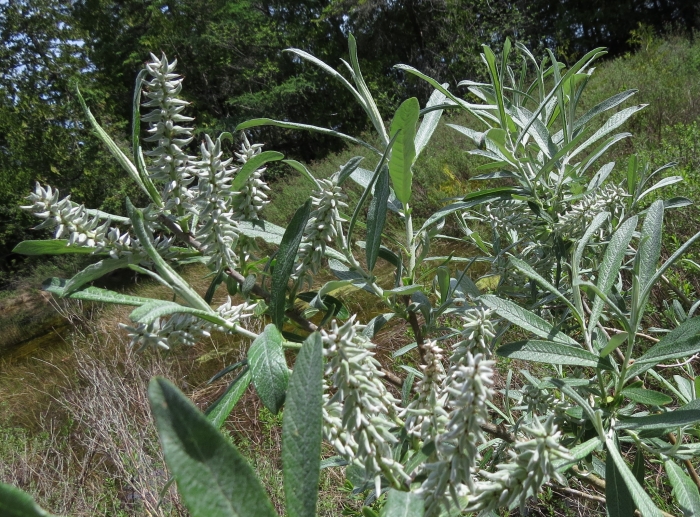Sageleaf Willow
(Salix candida)
Sageleaf Willow (Salix candida)
/
/

Adam Kranz
Public Domain
Image By:
Adam Kranz
Recorded By:
Copyright:
Public Domain
Copyright Notice:
Photo by: Adam Kranz | License Type: Public Domain | License URL: http://creativecommons.org/publicdomain/zero/1.0/ | Rights Holder: Adam Kranz | Publisher: iNaturalist | Date Created: 2019-06-20T11:14:38-07:00 |















































Estimated Native Range
Summary
Salix candida, commonly known as Sageleaf Willow, is a deciduous shrub native to wetlands, including bogs, fens, marshes, and along the edges of ponds and streams in the Northeastern and North Central United States, as well as across much of Canada. It typically grows to a height and width of 3-6 feet (0.9-1.8 meters), featuring a rounded, dense form. The leaves are a distinctive silvery-white due to a dense covering of silky hairs, which is particularly noticeable in spring and early summer. Sageleaf Willow produces small, inconspicuous yellowish catkins in early spring before the leaves emerge, which are attractive to pollinators.
Sageleaf Willow is valued for its ability to thrive in wet conditions and is often used in rain gardens, wetland restoration projects, and for erosion control along waterways. It is also appreciated for its unique foliage texture and color, which can add visual interest to water features or boggy garden areas. This willow prefers full sun but can tolerate partial shade and requires consistently moist to wet soil conditions. It is adaptable to a range of soil types, including clay, but good drainage is not necessary. While generally low-maintenance, it can be susceptible to willow beetle and other pests common to willows. Pruning may be necessary to maintain its shape and encourage healthy growth.CC BY-SA 4.0
Sageleaf Willow is valued for its ability to thrive in wet conditions and is often used in rain gardens, wetland restoration projects, and for erosion control along waterways. It is also appreciated for its unique foliage texture and color, which can add visual interest to water features or boggy garden areas. This willow prefers full sun but can tolerate partial shade and requires consistently moist to wet soil conditions. It is adaptable to a range of soil types, including clay, but good drainage is not necessary. While generally low-maintenance, it can be susceptible to willow beetle and other pests common to willows. Pruning may be necessary to maintain its shape and encourage healthy growth.CC BY-SA 4.0
Plant Description
- Plant Type: Shrub
- Height: 3-6 feet
- Width: 3-6 feet
- Growth Rate: Rapid
- Flower Color: N/A
- Flowering Season: Spring
- Leaf Retention: Deciduous
Growth Requirements
- Sun: Full Sun, Part Shade
- Water: High
- Drainage: Fast, Medium, Slow
Common Uses
Bee Garden, Bird Garden, Butterfly Garden, Deer Resistant, Low Maintenance, Water Garden
Natural Habitat
Wetlands, including bogs, fens, marshes, and along the edges of ponds and streams
Other Names
Common Names: Hoary Willow , Sage Willow , Sage-Leaved Willow , Saule Tomenteux
Scientific Names: Salix candida , Salix incana , Salix candida var. denudata , Salix candida f. denudata , Salix candida f. candida , Salix candidula , Salix tomentosa , Salix candida var. tomentosa , Salix nivea , Salix velutina
GBIF Accepted Name: Salix candida Flüggé ex Willd.